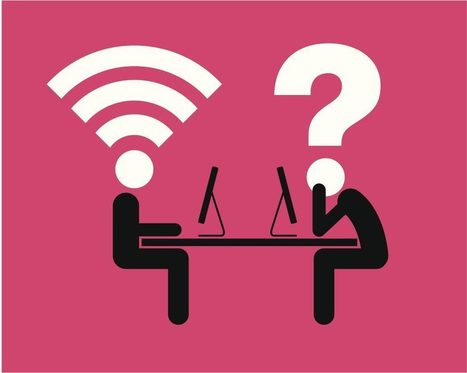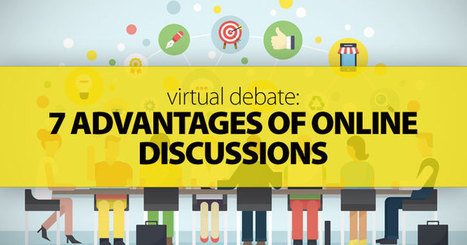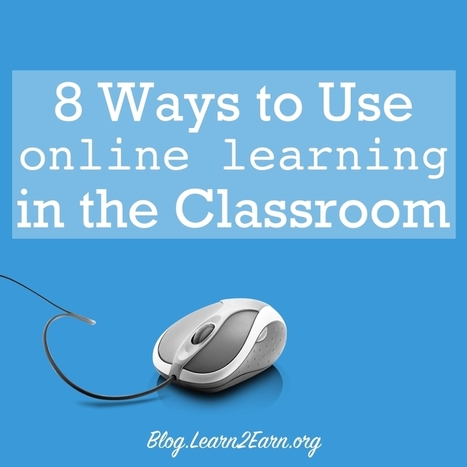 Your new post is loading...
 Your new post is loading...
"Whatever one chooses to call it, this method of learning–which combines classroom and online education–is going places and making headlines along the way. While education experts continue to debate the efficacy of hybrid learning, its very existence has challenged them to re-evaluate not just technology’s place in (and out of) the classroom, but also how to reach and teach students more effectively."
Via EDTECH@UTRGV
Engaging students through a computer screen requires a unique approach to pedagogy and innovative course design. The feeling of “getting it right” typically involves a good deal of testing and modification given the wide array of design formats and technology tools available, not to mention the varying needs of students, many of whom are underprepared for online learning (Bettinger & Loeb, 2017). Common Student Challenges In online courses, certain student challenges tend to come up time and again, which disrupts learning or impedes completing coursework on time.
Are your learners failing to apply the acquired knowledge from online learning to their jobs? How do you ensure effective knowledge transfer? Answer these 10 questions before, during, and post eLearning development and ensure effective knowledge transfer.
What is the biggest challenge that educators and trainers in various capacities face today? Undoubtedly, it is dealing with the constantly dropping learner attention spans and engaging them through the learning session. Online learning bears the most brunt of this issue since there is no human touch involved, and you can’t even see the learners’ reaction in-person. So what can you do to address this issue? Well, interactivity could be one of your best bets to ease this problem.
For a long time, teaching was teacher-centered: the teacher dispensed information through lecture, handouts, or presentations; the students absorbed the information by listening and taking notes. It was repetitive, could become monotonous, and left little room for student exploration or creativity. It was also detrimental to students who couldn’t keep pace with the teacher’s lessons or students who learned in way different from the teacher’s presentation
With so many educational tools at their disposal, more and more teachers are combining synchronous and asynchronous online learning to create a blended classroom environment.
This blended approach provides a number of advantages to both instructors and students, who can benefit from the best of both options to achieve an optimal online educational experience.
Increasingly, students are taking advantage of online learning to achieve a higher education. With blended classrooms, educators can make sure these students are benefiting from solid instruction – and still learning at their own pace. Students can shorten the time dedicated to writing papers and researches thanks to common form of research submission that is used on online learning platforms,
Universities will be busy this year adapting to the changes introduced by the government’s higher education reforms. But they mustn’t forget that there is more to the future of higher education than the teaching excellence framework ratings exercise: digital learning will also take centre stage.
While I am in the early stages of planning my online course, I am also in the middle of taking two of them! It made me wonder how many people who teach online courses have gotten the opportunity to take one? We've all taken plenty of face to face classes for years on end. …
Via Rosemary Tyrrell, Ed.D., Becky Roehrs
The “Research Seminar: Theories for learning with emerging technologies” with Dr. Terry Anderson, was organized by the Edul@b research on September 15, 2016. This Seminar looks at both theories that propel and guide online learning as well as the research paradigms that help shape our research on online learning and teaching.
Yoram and Edith Neumann, who have been involved with online education for decades, share some lessons about what factors most help students learn.
Time and time again, when dealing with teachers and academics, who have been seriously involved in online learning, I have found that they gained enormously from the experience. They become better teachers.
"As the world of online learning expands, professors are still working to find the best way to effectively communicate knowledge through a computer, tablet or cell phone screen. Professor Mauro Guillen, who teaches accounting, believes that there is definitely more work to be done."
Via EDTECH@UTRGV
How to facilitate such discussions is confusing to many teachers, and online discussion threads and chatrooms may be seen as a poor substitute for the “real” thing, an evil necessity of the online class. However, although there are some barriers such as its more decontextualized nature, in comparison to face-to-face discussion, there are advantages that are unique to the online discussion that can be built on by the instructor while the drawbacks are minimized.
Via Nik Peachey
|
"Online learning has become not only a common alternative to physical classes, but a well-regarded change maker in the education ecosystem. Not only does it eliminate the noise of who’s wearing what, disruptive students, and classes cancelled due to snow days, it is becoming the surest and easiest way to treat all students equally. The gregarious students no longer take over the class and the quiet ones are not ignored in their silence. The popular kid gets no more recognition than the wallflower. If you teach online, you know what I mean."
Via EDTECH@UTRGV
Pam McKinney here live blogging the final keynote from the LILAC conference featuring Professor Alison Littlejohn, Dean of learning and teaching in the faculty of social sciences at the University of Glasgow. Allison began by outlining the neo-liberalisation of the higher education sector, positioning students as consumers and the rise in importance of the national student survey. Allison was involved with a project called “learning literacies in the digital age” which outlined the need for learning to focus on processes and literacies, not content. Allison discussed the power of MOOCs to disrupt education, and to give people the opportunity to learn in a different way, using digital technologies.
Thirty years of research in the scholarship of teaching and learning in higher education have demonstrated that when students are engaged in the classroom, they learn more (Pascarella and Terezini 1991, 2005). Classroom discussion is likely the most commonly used strategy for actively engaging students. Whether it is a seminar course centered on discussion or a lecture punctuated by moments of interaction with students, discussion is likely second only to lecture as the most frequently used pedagogical strategy.
As course creators, our highest priorities are to help learners master instructional objectives and transfer new knowledge and skills to real-life situations. At the beginning of a project, course development teams typically create a profile of their target learners. This information might include the number of people taking the class, their job roles, locations, and experience with the subject matter.
In order to create meaningful eLearning experiences, you have to know how to approach your adult audience from an Instructional Design standpoint. How do you they assimilate knowledge? What are their key motivators? How can you create the most effective eLearning environment based on their needs? Here are 10 adult learning principles that are backed by adult learning facts and stats.
Pause procedure incorporates many best practices of active learning, including instructor presence, metacognition, and outcomes-based learning.
"Online training success relies heavily on memory retention, active recall, and positive reinforcement. In this article, I'll share 9 innovative ways to reinforce key concepts in online training."
Via EDTECH@UTRGV
"Somewhere between our collective obsession with predictive analytics and infatuation with adaptive learning, higher education wonks and practitioners are making time to deconstruct the quality attributes of online courses."
Via EDTECH@UTRGV
Stories about blended learning programs. In these programs, students learn partly at a supervised physical location away from home (such as school) and partly through content delivered online. Students also have control over the time, place, path, and/or pace of learning.
By Stacy Zeiger As most educators will agree, technology has changed the way teachers teach and students learn. While, in many cases, the actual content has not changed, the method of delivery has. This is particularly true when it comes to online learning.
I work on online teaching, but what I really care most about is residential learning. The reason that I focus on online programs and courses is that, in my experience, online teaching is a catalyst for improving campus-based residential learning.
The I Do, We Do, You Do structure of Direct Instruction is used to present new material, provide constructive feedback, and allow space for collaboration.
|



 Your new post is loading...
Your new post is loading...






















![[Un]intended consequences of educational change: The need to focus on literacy development #lilac19 | Information Literacy Weblog | Information and digital literacy in education via the digital path | Scoop.it](https://img.scoop.it/yhH9CewzjcqLVSO178Xq_zl72eJkfbmt4t8yenImKBVvK0kTmF0xjctABnaLJIm9)















